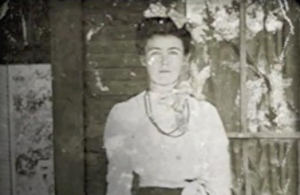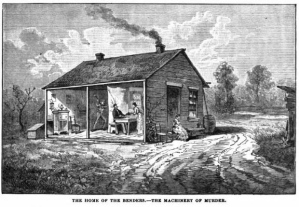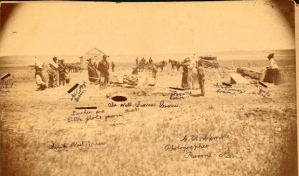Not much is certain about the murderous Bender family except to say they were acknowledged to be America’s first serial killers — at least the first discovered. Were they a family? Probably not. Was Bender their real name? Almost certainly not. Even the number that they killed is uncertain. It was known to be around 15, probably more than 20 and it could have been a great many more. Were they ever captured, or shown more informal justice by vengeful neighbours? Again, probably not, despite a dozen wild reports to the contrary for 20 years after they fled the scene of their murders.
They were the Sweeney Todds of the prairies. In 1870 this reportedly German foursome (though again probably only Pa Bender was born in Europe — and probably in Holland rather than Germany) arrived in a part of Kansas that had recently been emptied of native Americans to make room for homesteaders. They were part of a wagon train of spiritualists seeking pastures new. Ma and Pa Bender were already elderly. There they lived with two grown-ups who they claimed to be their son and daughter. They may have been brother and sister, or husband and wife, though judging from the Bender’s misplaced moral compass about murdering, you would not discount the possibility that they were both.
They built their little house on the prairie about six or seven miles north of the hamlet of Cherryvale. This charmingly named ville’s other claim to fame was that silent film actress Louise Brooks and Lucille Ball’s co-star in all those I Love Lucy shows, Vivian Vance, were both born there. That was just 40 years after the Benders did their killing.
Back in the early 1870s the town was getting a bit of a reputation as some kind of landward Bermuda Triangle. Too many people disappeared in the vicinity.
The Benders’ isolated one storey, one room plank-walled frame house not much bigger than a garage was surrounded by a two acre garden. It was beside an old buffalo trail that ran across a flat and treeless plain. The trail had become the preferred route out of Independence Missouri and eventually became known as the Santa Fe Trail. So the Benders weren’t short of passing trade for their ramshackle dry goods and liquor store where travellers could get a meal, forage for their horses and a bed for the night.
Judging from the evidence at the time, it was supposed that the two strong women who mistressminded the killing spree. The mother, who was probably named Almira Meik or Mark, had already run through a fair number of husbands, all of whom met with accidents involving head injuries. She and the daughter Kate were probably the only part of the quartet related by blood. Kate was said to be a bit of a looker as compared with the average frontier maid. She was a spiritualist and phrenologist, fortune teller and healer who took out small ads for her services in the local paper. Around Cherryvale farmers’ wives called her a she-devil and said the others “dare not disobey her on anything”.
Kate was also disposed to make flirtatious conversation with single travellers as they rode by, which often led them to make the fatal mistake of stopping off at the Benders for a meal or the night.
Being flattered by Kate into taking the seat at the head of the table was the guest’s biggest and last mistake. This put their back against a stained old canvas wagon sheet that divided the shop part of the cabin from the two beds in back. At some time during the meal one of the Benders (and my betting is on old Ma Bender), took a swipe at the silhouetted figure through the canvas with a club hammer. Just to finish them off the hapless traveller had his throat slit and was dumped in the cellar until a grave was dug in the garden.
Their motive was robbery. They got away with it for more than two years, netting a few thousand dollars. Relatives and friends of some of the deceased came and went, enquiring of them whether they had seen their loved ones, but in those years there were enough other things to kill you on the Western Plains that suspicion never really focussed on this strange little coven.
But inevitably they would eventually fall to murdering someone whose connections were too good for their disappearance to pass without something of an outcry. That man was Dr William York. In March 1873 he had set out to find out what had happened to two previous Bender victims, his friend, a recently widowed George Longcor and his daughter, heading west to start afresh after his wife’s death. Inevitably Dr York encountered the Benders and got hammered. What the Benders did not contemplate was that York’s two brothers, a state senator and colonel, had the clout to investigate in a way that previously had not been done. By May the Benders had fled their farm, leaving a calf tied up to starve to death.
Once word got out that they had gone the place was searched, the bloodstained cellar discovered, the garden probed and Dr York discovered. Within days more than 200 (some put the number at 1000) rubberneckers had gathered at the murder site as the bodies were exhumed. Two special trains were run to bring the ghoulish to hold their noses and peer down the now empty graves. Postcards and stereoscopic views of the gruesome garden were sold.  The spectators turned out to be useful as, to make sure that no other bodies had been buried under the cabin, it was moved bodily. Crude forensics established that the hammers found inside the house fitted the wounds. Even cruder questioning of a man suspected of being an accomplice and receiving stolen goods ensued, to no real purpose. In an early version of waterboarding, one of them was hung for a time before being interrogated to tell what he knew. The vigilantes tried this a total of three times without success before they sent the man home confused and with a sore neck.
The spectators turned out to be useful as, to make sure that no other bodies had been buried under the cabin, it was moved bodily. Crude forensics established that the hammers found inside the house fitted the wounds. Even cruder questioning of a man suspected of being an accomplice and receiving stolen goods ensued, to no real purpose. In an early version of waterboarding, one of them was hung for a time before being interrogated to tell what he knew. The vigilantes tried this a total of three times without success before they sent the man home confused and with a sore neck.
The Benders’ wagon was found abandoned at a nearby railroad depot — they had given no thought to the horses, which were near to death. Of the Benders there was never again a confirmed sighting. Stories abounded — they were discovered and shot, hung, or burnt to death by a posse of vigilantes. Perhaps Ma Bender and the daughter killed the two men; perhaps they all went to Chicago, Mexico, Canada; lived with outlaws or Indians and started up their trade in murder robbery once more. It was a fact that no-one attempted to collect the substantial reward for their apprehension.
Once the souvenir hunters had finished with the cabin there was nothing left. Nowadays it’s site is anonymous farmland, though the farmers do keep an eye out for stray bones. The hammers are in the local museum.
So, if there’s any consoling takeaway message from this sordid tale of possibilities it is possibly this. Do not despair that the world is worse now than it was. It was always inhabited by Benders and always will be.
